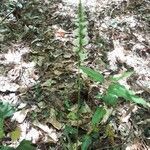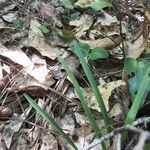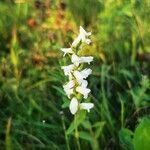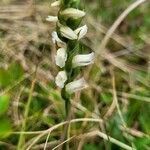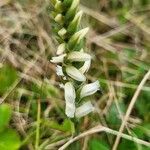Plants 10–50 cm. Roots few, slender to tuberously thickened, horizontally spreading to descending, mostly to 1 cm diam. Leaves persisting through anthesis or fugaceous, basal, sometimes on proximal portion of stem, ascending to spreading (flaccidly so because of membranaceous blades with thickened midribs); petiole usually slender, less than 6 mm wide; blade linear-lanceolate to linear-oblanceolate, oblanceolate, obovate, or elliptic, to 26 × 2 cm. Inflorescences: spikes very tightly to rather loosely spiraled, 3–4 flowers per cycle of spiral, rarely in loose spiral with 5 or more flowers per cycle; rachis moderately to densely pubescent, some trichomes capitate, glands obviously stalked. Flowers white to ochroleucous, creamy, or ivory, occasionally green or rarely yellowish, nodding only at base of perianth or occasionally ascending, urceolate to gaping, base usually appearing only slightly inflated, claw of lip at low (less than 30°) angle to lamina, or occasionally not opening; sepals distinct to base, 6–12 mm; lateral sepals appressed to spreading, apices incurved or sometimes straight, sometimes arching above flower; petals linear-lanceolate, 6–12 mm, apex acute to obtuse, occasionally broad and liplike; lip often yellow centrally, ovate to oblong in general outline, usually constricted at middle, 6–10.5 × 2–7.5 mm, base ± prominently dilated, suborbiculate, orbiculate, or linear, margins crenulate, lacerate or sometimes entire, apex acute to rounded distally, glabrous; veins several, branches parallel; basal calli usually incurved, prominent to conic, small, mostly 0.5–1.2 mm, or sometimes lip undifferentiated from petals; viscidia linear to linear-lanceolate; ovary 3–14 mm. Seeds polyembryonic, often also monoembryonic, rarely wholly monoembryonic; typically showing irregularities such as embryos developing through or outside testa or naked embryos mixed with whole seed. 2n = 45, 60.
More
Plants 1–4(–8) dm; basal lvs narrow, to 30 cm, 5–50 mm wide; cauline sheaths 3–8, sometimes with a spreading-recurved blade; infl 2–18 cm, with shortly glandular-hairy axis, dense, the fls ± in 3 or 4 vertical ranks, 8–11(–15) mm, individually widely spreading or somewhat declined, urceolate-cylindric, only the upper sep and lateral pet connivent, the lateral sep looser but scarcely spreading; lip moderately to sometimes (var. ochroleuca) strongly arcuate-recurved, ovate or ovate-oblong or obcuneate, often dilated and cordate at base, erose or crisped around the broad summit, somewhat yellowish-green in the center, the fls otherwise white or whitish (or more ochroleucous in var. ochroleuca); callosities at base of lip often 1 mm or more, higher than thick; viscidium 1–2 mm, narrow; 2n=30, 45, 60, 61, the plants often asexual. Open, moist, often sandy places; N.S. and Que. to se. N.D., s. to Fla. and Tex. Aug., Sept. Common, variable, and imperfectly divisible into an indefinite number of ecogeographic phases. Robust, diploid plants, to 8 dm, with fls 10–14 mm, often spreading by stolon-like roots, and with the cauline sheaths bearing spreading, ± recurved blades, mainly on the se. coastal plain, often in estuaries, form the ill-defined var. odorata (Nutt.) Correll; the fls are said to have the odor of vanilla, in contrast to the inodorous fls of others vars. (S. odorata) Plants with slightly more yellowish fls and a strongly decurved lip with a relatively long claw (0.8–1.5 mm, in contrast to 0.3–0.8 mm in var. cernua) thought to be mainly diploid but not always sexual, occurring from P.E.I. and s. N.S. to Mich., s. to Ky. and the mts. of Va. and N.C., have been distinguished as var. ochroleuca (Rydb.) Ames. (S. ochroleuca; S. steigeri)
